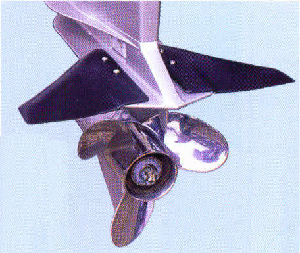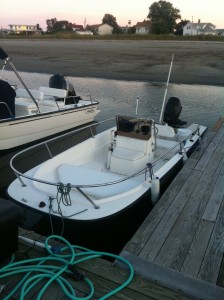







A site dedicated to discussion of these classic boats
25 Sep, 2012 2 Comments
Filed in: customization, parts
 Last year I replaced the ancient 1981 Evinrude 50 that came with my Wahoo! 16.2 with a more powerful and reliable 1995 3 cylinder Johnson 50. After the Evinrude, which was hard to start and tended to stall in idle, it was nice to have an engine that started first or second turn of the key every time. But even with the newer engine I still wasn’t happy with how long it took to get my Wahoo! up on a plane. It took too much throttle to get the nose down. And then once it did come down often the boat was going too fast for conditions (lotsa rocks in Boston Harbor).
Last year I replaced the ancient 1981 Evinrude 50 that came with my Wahoo! 16.2 with a more powerful and reliable 1995 3 cylinder Johnson 50. After the Evinrude, which was hard to start and tended to stall in idle, it was nice to have an engine that started first or second turn of the key every time. But even with the newer engine I still wasn’t happy with how long it took to get my Wahoo! up on a plane. It took too much throttle to get the nose down. And then once it did come down often the boat was going too fast for conditions (lotsa rocks in Boston Harbor).
So I wanted to be able to plane more quickly, with less throttle, and at lower speeds. And I wanted to do it without having to increase horsepower. Following the recommendation of a friend, this spring I looked into adding a hydrofoil to the engine. Researching online I found plenty of back and forth on message boards about the relative merits of hydrofoils.
The cons:
The pros:
And the qualified statements:
Shopping around I found quite a few makes/models to choose from, with prices ranging from $40 to $150. While most hydrofoils require drilling holes in the engine’s cavitation plate (so you can bolt it on), a few of the more expensive models advertised themselves as clamp on/no drilling required. That had some appeal until I read the customer reviews which were generally not favorable.
In the end I opted for Doel-fins, one of the earliest, simplest, and most affordable outboard hydrofoils. I didn’t even have to pay the $40 they cost since I was able to scavenge a set off a boat that that had washed ashore on a local beach and was abandoned by its owner. Installation was easy. It took less than half an hour and drilling holes in the cavitation plates was not the big deal I feared it might be.
Three months of boating later and the verdict is in: What a difference!!! I don’t have exact numbers but I would guess that with the Doel-fins my Wahoo! now achieves a plane at 40% less throttle than it took before. And it now planes at speeds as low as 10-12 mph. The ride and handling are smoother, with nice easy turns and a big reduction in porpoising. And my guess (though I don’t know for sure) is that with the faster planing I’m saving quite a bit of gas.
All in all, couldn’t be happier. ![]()
13 Jul, 2012 No Comments
Filed in: customization, servicing
 These are notes to myself mostly and may be of little interest to visitors of the site. But then again you never know…
These are notes to myself mostly and may be of little interest to visitors of the site. But then again you never know…
Finally got the boat in the water July 6, just in time for the Blessing of the Fleet the next day. The Blessing went great, a fun party with kids playing on the beach while the grownups downed barbeque and beer. Later in the evening there was a DJ doing 60s-friendly music and there was dancing on the docks. Only hitch was that the priest never showed up. So the 2012 Point of Pines Yacht Club is for the moment an unblessed fleet.
As with 2011 I was disappointed how at long it took me to get the boat in the water. But I did get a lot of work done including new bottom paint, a new fuel fill and hose, a number of patches to the fiberglass, raising the floors of the storage compartments, sorting through the wiring in the console, adding doel fins to the engine, relocating the fishfinder transducer, painting the console dashboard, painting the engine, repairing a broken section of the wiring/steering harness through-hull rigging tube, straightening a bent skeg, and refinishing all the wood. Not too shabby considering a lot of rainy weekends and that I was also planting two separate gardens, painting the garage, and going to my son’s little league games three times a week.
Remembering last year’s launch where a mile from the dock on my way to the yacht club I slammed into some rocks and dinged the prop pretty good, this year I looked at the maps more carefully and kept right to the channels. A nice, easy five mile run with no worries.
Some of the repairs/modifications I made before launching this year that seem to have actually improved things:
Stuff I either didn’t get to in the off-season or which needs fixing:
findre August 9, 2015
findre August 9, 2015
findre August 9, 2015
Lcolon7 June 23, 2015
MikeQ June 24, 2015